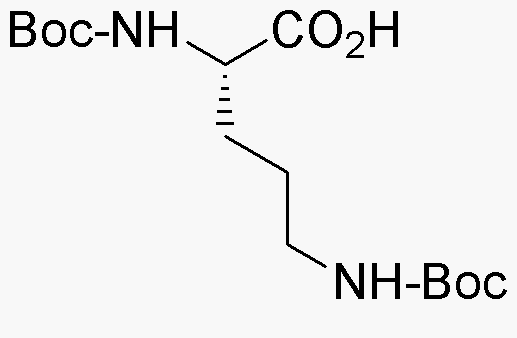Na,d-Bis-Boc-L-ornithine is widely utilized in research focused on:
- Peptide Synthesis: This compound serves as a key building block in the synthesis of peptides, particularly in the development of therapeutic agents. Its protective Boc groups facilitate selective reactions, enhancing the efficiency of peptide assembly.
- Drug Development: In pharmaceutical research, it is used to create prodrugs that improve the bioavailability of active pharmaceutical ingredients, making medications more effective and easier for patients to use.
- Bioconjugation: The compound is valuable in bioconjugation processes, allowing researchers to attach biomolecules to surfaces or other molecules, which is crucial in developing targeted drug delivery systems.
- Protein Engineering: It is employed in the modification of proteins to enhance their stability and functionality, which is essential in creating more effective enzymes and therapeutic proteins.
- Research in Cancer Therapeutics: The compound is being explored for its potential in cancer treatment, particularly in designing inhibitors that target specific pathways involved in tumor growth.
Informations générales
Propriétés
Sécurité et réglementation
Applications
Na,d-Bis-Boc-L-ornithine is widely utilized in research focused on:
- Peptide Synthesis: This compound serves as a key building block in the synthesis of peptides, particularly in the development of therapeutic agents. Its protective Boc groups facilitate selective reactions, enhancing the efficiency of peptide assembly.
- Drug Development: In pharmaceutical research, it is used to create prodrugs that improve the bioavailability of active pharmaceutical ingredients, making medications more effective and easier for patients to use.
- Bioconjugation: The compound is valuable in bioconjugation processes, allowing researchers to attach biomolecules to surfaces or other molecules, which is crucial in developing targeted drug delivery systems.
- Protein Engineering: It is employed in the modification of proteins to enhance their stability and functionality, which is essential in creating more effective enzymes and therapeutic proteins.
- Research in Cancer Therapeutics: The compound is being explored for its potential in cancer treatment, particularly in designing inhibitors that target specific pathways involved in tumor growth.
Documents
Fiches de données de sécurité (FDS)
La FDS fournit des informations de sécurité complètes sur la manipulation, le stockage et l’élimination du produit.
Spécifications du produit (PS)
Le PS fournit une description complète des propriétés du produit, notamment sa composition chimique, son état physique, sa pureté et les exigences de stockage. Il détaille également les plages de qualité acceptables et les applications prévues du produit.
Certificats d'analyse (COA)
Recherchez des certificats d'analyse (COA) en saisissant le numéro de lot du produit. Les numéros de lot et de lot se trouvent sur l'étiquette d'un produit, après les mots « Lot » ou « Lot de fabrication ».
Numéro de catalogue
Numéro de lot/série
Certificats d'origine (COO)
Ce certificat d'exploitation confirme le pays dans lequel le produit a été fabriqué, et détaille également les matériaux et composants utilisés et s'il est issu de sources naturelles, synthétiques ou autres sources spécifiques. Ce certificat peut être requis pour les douanes, le commerce et la conformité réglementaire.
Numéro de catalogue
Numéro de lot/série
Fiches de données de sécurité (FDS)
La FDS fournit des informations de sécurité complètes sur la manipulation, le stockage et l’élimination du produit.
DownloadSpécifications du produit (PS)
Le PS fournit une description complète des propriétés du produit, notamment sa composition chimique, son état physique, sa pureté et les exigences de stockage. Il détaille également les plages de qualité acceptables et les applications prévues du produit.
DownloadCertificats d'analyse (COA)
Recherchez des certificats d'analyse (COA) en saisissant le numéro de lot du produit. Les numéros de lot et de lot se trouvent sur l'étiquette d'un produit, après les mots « Lot » ou « Lot de fabrication ».
Numéro de catalogue
Numéro de lot/série
Certificats d'origine (COO)
Ce certificat d'exploitation confirme le pays dans lequel le produit a été fabriqué, et détaille également les matériaux et composants utilisés et s'il est issu de sources naturelles, synthétiques ou autres sources spécifiques. Ce certificat peut être requis pour les douanes, le commerce et la conformité réglementaire.


